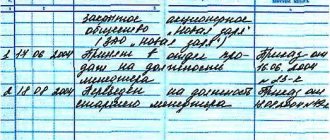Content
- Features of dismissal in the order of transfer to another organization
- If the manager refuses to let the employee go
- Translation and processing
- Types of transfers
- Options for dismissal in order of transfer to another organization
- Step-by-step instructions for dismissal of a transfer initiated by an employee
- Dismissal of an employee by his consent (the initiative comes from the manager)
- Basic documents for registration of dismissal
- Compensation upon dismissal by transfer
- Leave on transfer
- Who can be dismissed by transfer?
- Advantages and disadvantages of dismissal
- Conclusion
How to transfer several employees from one organization to another at the employer’s suggestion
Transfer employees from one organization to another through dismissal under clause 5, part 1, art. 77 of the Labor Code of the Russian Federation in the order of transfer to another employer. The procedure for dismissing several employees is the same as we described above; no special rules are established by law. In particular, be sure to obtain the employee’s consent to such dismissal and coordinate the transfer with the new employer; for example, you can draw up a tripartite agreement with each employee. Then issue a dismissal order, make an entry in the work book, make calculations upon dismissal, including paying compensation for unused vacation.
Features of dismissal in the order of transfer to another organization
To better understand the depth of the issue, let's start with a definition.
Dismissal by transfer is the termination of an employee’s contract (employment contract) with one employer and its simultaneous conclusion with another employer.
For example, an employee occupies a permanent position in one organization, but he was offered a more profitable job at another enterprise. Then he can transfer from one place of work to another. In fact, the employee quits the old enterprise and gets a job at a new one.
But before dismissing a transfer employee, the manager must have certain reasons. This is a letter of invitation from a future employer to a present one. Subject to the employee's consent and written request, the current manager may dismiss the transfer employee.
The Labor Code does not prescribe a clear algorithm for the manager’s action in this case. Mention of transfer to another organization can be found in Article 77 of this document. Therefore, when preparing documents for dismissal due to transfer, reference is made to Article 77 of the Labor Code of the Russian Federation.
In fact, business managers do not receive much benefit from this process. The same cannot be said about the employees. In case of dismissal in this way, the state protects the rights of the citizen, thanks to which he receives 100% employment.
New employer guarantees
The transfer of an employee to another place of work is associated with the execution of a new employment contract. According to the Labor Code of the Russian Federation, Article 64, the period for processing employee documents cannot exceed one month from the date of dismissal from the previous place of work. Problems that an employee has with a new organization, from delays to refusal to draw up an employment contract, are grounds for the employee to go to court.
Do not forget that the period of 1 month during which guaranteed employment occurs is an absolute value and cannot be extended either during holidays or due to temporary disability (illness). An employee who exceeds the period allowed by law to maintain job security loses the legal right to job security.
If the manager refuses to let the employee go
If an employee has expressed a desire to resign by transfer, but his employer is against this, then the employee has no choice but to leave of his own free will. In this case, the employee is left without protection before the new manager.
That is, if dismissal occurs due to transfer, then the receiving party must employ the employee within a month, otherwise he may go to court. By a court decision, they can either reinstate him to his previous place of work, or oblige the head of the receiving enterprise to hire this employee.
If the dismissal occurs at will, then there will be no one to file a claim with.
Transfer to another location
Permanent employment includes transfer to another location together with the employer. Such a transfer is considered to be a change in the location of the organization - a transfer beyond the administrative-territorial boundaries of the previous locality. In practice, it does not occur so often, however, the employer needs to be aware of it.
Let us clarify that the location of the employer—a legal entity—is determined by the place of its state registration, which is carried out at the location of its permanent executive body (Article 54 of the Civil Code of the Russian Federation). The location address is recorded in the constituent documents and in the Unified State Register of Legal Entities.
Transfer to another location together with the employer is carried out with the consent of the employees. The employer must notify all employees about such a transfer in advance and invite them to move with him. Since the terms of such warning are not established, one should be guided by Art. 74 of the Labor Code of the Russian Federation and apply a two-month notice period.
Note.
If the organization's legal address has changed and the executive body has changed its location, but the actual place of work of the employees remains the same, there is no need to complete a transfer.
We believe that it is not necessary to send a transfer proposal to each employee, but rather to issue one order, but bring it to the attention of each employee against signature.
If one of the employees expresses a desire to continue working with this employer in another locality, an additional agreement is concluded with him to the employment contract on transfer to another locality, on the basis of which an order is issued.
Since, according to the Rules, an entry about a permanent transfer must be made in the work book, it is also necessary to make an entry about a transfer to another location, even if the employee remains in the same position and in the same structural unit. A sample of such an entry is not provided, but it may look like this: “Transferred to another area together with the employer.” A similar entry is made in the employee’s personal card.
If the employee agrees to move to work in another area, the employer is obliged to compensate:
— expenses for moving the employee, his family members and transporting property (except for cases where the employer provides the employee with appropriate means of transportation);
- expenses for settling into a new place of residence.
The specific amounts of reimbursement of expenses are determined by agreement of the parties to the employment contract (Article 169 of the Labor Code of the Russian Federation).
Employees who refuse to be transferred to another location are subject to dismissal under clause 9, part 1, art. 77 of the Labor Code of the Russian Federation - refusal to transfer to another location together with the employer. At the same time, by virtue of Art. 178 of the Labor Code of the Russian Federation, the employee is paid severance pay in the amount of two weeks’ earnings.
Types of transfers
Dismissal due to transfer can be external or internal.
Internal transfer (transfer within the company) is when the employer remains unchanged, but the employee’s position, place of work, etc. changes. Such a transfer can be either permanent or temporary.
External transfer (transfer to another company) – occurs when an employee moves from one employer to another. At the same time, at the new place of work they are required to hire him only for a permanent position.
In any case, the employee’s consent is a prerequisite for the transfer.
Third party transfer
In addition to these types of transfer of an employee from one employer to another, another option is possible in which the initiator of the transfer is a third party. An example would be the transfer of an employee in alternative civil service to another employer. The basis for the transfer of such an employee is an order issued by the federal executive body of the Russian Federation.
Most often we are talking about citizens liable for military service who, in exchange for military service, undergo alternative service in civilian organizations.
Options for dismissal in order of transfer to another organization
There are several options for dismissing transfer employees. It all depends on who takes the initiative.
Option 1: The employee independently found an organization where he would like to work.
If the head of this organization is ready to hire an employee, then he writes a letter of invitation addressed to the current head, where he confirms that he is ready to hire his employee.
This written notice will be mailed or personally delivered to the incumbent. If he agrees with the transfer, the employee writes a letter of resignation in the order of transfer, on the basis of which a dismissal order is issued, an entry is made in the work book, personal card, final payment is made, and documents are issued in person (work book and income certificate for 2 years).
With them, the employee goes to a new place of work, where he is hired.
Option 2: The initiative comes from the manager.
There are times when an organization urgently needs to reduce its workforce or fire some staff. In this case, the employer can independently find a new place of work for the employee. Managers discuss all the nuances and receive written consent to the transfer from the employee. A tripartite agreement is signed, which specifies the position, salary, working conditions, etc.
What follows is the standard translation procedure.
Each of these options has its own characteristics. Therefore, any manager needs to know and be able to fill out all the necessary documentation. Now we will analyze each translation option in detail so that you know all the intricacies of this procedure.
Procedure for completing a translation
The initiator of a transfer to another company can be both the employee and his employer.
But in both situations it is necessary to terminate one employment contract and enter into a new one in return. In this case, no additional agreement is allowed. This is explained by the fact that this procedure involves not two persons, but three: the employee, the current and potential employers. So, in order to make a transfer, the written consent of the following participants is required:
- employee;
- the employer for whom he currently works;
- an employer who wants to employ this personnel.
Translation stages:
- The first step before translation is correspondence. It passes between the organization in which the person works and the company that wants to host this employee. The second enterprise asks the first to transfer the person to them. At this stage, the most important document is the invitation letter, which contains a request for transfer. This document shows that the inviting party agrees to host the employee.
- At the second stage, it is necessary to obtain the consent of the frame itself. The main factor here is who initiated the transfer - the employer or the employee. If the employer, then it is imperative that the employee writes a written agreement. Consent can be expressed in the following forms:
- The inscription on the employer’s offer of transfer: “I agree to the transfer”;
Separately written agreement.
Also, as consent, a resignation letter may be considered, the reason for which is a transfer to another organization. An invitation letter from the new company can be attached to this application. Consent is also considered a general agreement between the employer and employee on the transfer, which is confirmed by the termination of the employment contract.
The employee must receive monetary compensation in the form of salary for the time he worked, as well as for unused vacations. They settle accounts with him on the day of actual dismissal . If for some reason a person was unable to receive the money within the period established by law, then he can come for payment no later than the next day after declaring his desire to receive the necessary compensation.
If dismissal by transfer occurs at the time of illness, then the management of the organization must pay the person the entire amount due to him as sick leave. If an enterprise has no money, this is not a reason for non-payment of financial compensation.
Step-by-step instructions for dismissal of a transfer initiated by an employee
- The current employer receives a letter of invitation from an organization that is ready to hire his employee. It is drawn up in any form on the organization’s letterhead. It must indicate the position for which the employee is being hired and the approximate date of employment. Sometimes such a letter indicates the amount of the future salary, but this is not necessary.
- An employee who wants to transfer writes a statement addressed to the head of the organization stating that he wants to resign due to the transfer.
- After signing the application, a letter is sent to the organization that will employ the dismissed employee confirming the transfer. This item is optional, and the letter is drawn up for management’s consideration.
- Next, the head of the enterprise creates an order, where it is necessary to indicate on whose initiative the transfer is being carried out “In the order of transfer at the request of the employee.” In addition, the order must make reference to clause 5, part 1, article 77 of the Labor Code of the Russian Federation.
- After signing the order, it is registered in the Register of Orders for Personnel.
- The order must be communicated to the employee in writing.
- After this, in the employee’s personal card (T-2) on the fourth page, an entry is made about the employee’s dismissal, where a reference is also made to Art. 77 Labor Code of the Russian Federation. The employee must be familiar with all the records, after which he puts his signature on the card.
- After this, a corresponding entry is made in the employee’s work book, according to the Instructions for filling out the work book. There are 2 recording options:
In addition, the work book indicates the number of the dismissal order and its date. The entry must be made without abbreviations, certified by the seal and signature of the manager.
- On the last working day, the employee is paid by issuing a settlement note (form T-61). Thus, the employee receives compensation for vacation and wages for days worked.
- After which the former employee is given a work book. An entry about this must be made in the Book of Accounting for the Movement of Labor Books, where the employee puts his signature.
- In addition to the work book, a certificate of salary for 2 months is issued.
- After this, the dismissed employee is obliged to find a new job within 1 month.
- When registering at a new location, a note is made in all relevant documents that it has been accepted for transfer.
How is an application made?
The information is entered into the personal card and work book on the last working day. The wording may be as follows: “Dismissed due to transfer at the request of the employee (or with the consent) to (name of enterprise), paragraph 5 of Article 77 of the Labor Code of the Russian Federation.” Transfer through dismissal in one organization is not allowed.
Issuing a transfer order
Article 64 of the Labor Code of the Russian Federation guarantees a citizen employment. The employer who sent the invitation cannot back down and refuse the citizen to sign the contract. The documents guaranteeing employment in the new organization are an invitation to transfer and the consent of the citizen. If the employer decides to refuse employment to the invited employee, he can file a complaint with the labor inspectorate or sue him in court. If the court decides in favor of the plaintiff, it will oblige the new employer to sign a contract with him from the day following the day he left his previous job.
The consent of the receiving party must be expressed in writing - the employer must issue the applicant (employee or employer) a letter of guarantee, properly executed - with the corner stamp of the enterprise (or on letterhead), the signature of the manager, the seal (if any).
Dismissal of an employee by his consent (the initiative comes from the manager)
This version of the transfer procedure is similar to the previous one, so we will not repeat ourselves, but will talk about the differences and features of the transfer on the initiative of the manager.
- The heads of enterprises agree among themselves that one fires the employee, and the second hires. This can be confirmed by a letter of invitation (as in the first option).
- After this, the employee himself must be familiarized with the upcoming transfer. He must be told in writing about the position he will hold, the working conditions, and the salary amount. If an employee does not agree to a transfer, then no one can force him to change his job.
If the employee agrees to the transfer, he can write “I agree to the transfer” on the written notice, adding a date and signature. A tripartite agreement is drawn up.
- After which the receiving party receives a confirmation letter.
- At an enterprise where an employee is fired, the manager issues a dismissal order, which states that the dismissal occurs with the consent of the employee. It is also necessary to refer to Article 77 of the Labor Code of the Russian Federation.
- After which, appropriate entries are made in the work book and personal card, which also indicate that the dismissal is carried out with the consent of the employee . A sample record of dismissal in the order of transfer in the work book was discussed earlier in the first version.
- All records and orders must be presented to the employee against his signature.
- A settlement is made with the payment of all compensation, after which a work book and a certificate of income for 2 years are issued.
Also read: Dismissal of employment by agreement of the parties.
Translation and relocation - what's the difference?
Let's start with terminology. The Labor Code of the Russian Federation (Article 72.1) refers to a change of workplace without dismissal as a transfer. The position, the nature of the work performed, and the terms of the contract under which the citizen was hired do not change. Example: a retail outlet manager is transferred to a similar retail outlet owned by the same company without leaving the area. Labor payments also remained at the same level.
Lost in translation
This refers to fires, floods, earthquakes, epidemics of people or animals, various industrial and any other emergencies leading to massive negative consequences. Workers are distracted from their main place of work to prevent these consequences.
The legislation allows the transfer of an employee to work from the current employer to another employer (Part 2 of Article 72.1 of the Labor Code of the Russian Federation). At the same time, the employment contract at the previous place of work is terminated by transfer (clause 5, part 1, article 77 of the Labor Code of the Russian Federation).
Basic documents for registration of dismissal
All letters are written in any form. The application from the employee and the order from the manager must be drawn up in accordance with all the rules. Below we provide a table with which you can correctly draw up the necessary document.
| Application from an employee | 1. Name of the addressee; 2. Full name of the employee; 3. Title of the document (application); 4. The essence of the statement “Please fire me...”; 5. Date; 6. Signature. |
| Dismissal order (order) | 1. Name of the organization; 2. Name of the document and its number (Order No....); 3. Date of compilation; 4. Method of terminating the ore contract; 5. Full name of the dismissed employee; 6. Personnel number, position; 7. Basis for calculation; 8. Information about available documents that confirm the legality of dismissal due to transfer; 9. Date and signature of the manager; 10. The column “I have read the order,” where the resigning employee puts his signature. |
On whose initiative the translation can be made
If the transfer is carried out at the request of the employee himself, the basis for issuing the order will be the citizen’s application. To avoid misunderstandings, in this case it is recommended to obtain written confirmation of the upcoming employment from the future employer, otherwise - an invitation.
In this case, the specialist can be sure that he will be hired for a new position no later than in a month, and he will be paid for relocation if necessary.
In any case, you should inform the potential employer in advance about your desire to receive a transfer. The entry in the work book will contain an indication of the employee’s own desire. In case of transfer, the new employer does not have the right to refuse to hire the citizen. If there is a refusal to conclude an employment agreement, the organization will face penalties.
When transferring, the law provides another guarantee - new employees are prohibited from installing a test.
An employee who wishes to move to another organization is required, as a general rule, to work for a specified period, which is a maximum of 14 days. The reason is to respect the interests of the employer, who will need time to select a new employee to replace the departing one.
It happens that the transfer occurs within the framework of an agreement between cooperating companies. For example, an organization ceases its activities, but wants to employ its employees by transferring them to vacant positions. Then, taking into account the consent of the employees, an appropriate agreement is drawn up.
First, the administration of the closing enterprise sends a request to the second employer regarding the possibility of transferring a specific person. A request for several specialists at the same time is allowed. If the second organization agrees, it confirms this with a response letter. Then the first employer issues an order(s) regarding dismissal.
Compensation upon dismissal by transfer
On the last working day, a full payment is made to the employee. Most often this is payment for his days worked and compensation for vacation.
Let's look at how compensation is calculated using an example.
Example: Let’s assume that an employee quits on June 30, 2016, but he did not go on vacation this year. If his annual leave is 24 days, then the company must pay him compensation for 12 days.
Grounds for termination of an employment contract for transfer
- Company name.
- FULL NAME. and the position of the employee who is planned to be hired.
- Proposal to transfer an employee.
- The deadline for approval by the current employer and an indication of the form in which it should be given.
- The date from which the employee will start a new job, as well as the name of his position.
- Signatures of authorized persons.
3 party agreement
- the presence of a voluntary expression of will of 3 parties - the old and new employer, employee;
- the opportunity for an employee to dismiss by transfer by agreement - both with and without . For example, you can agree on a period of work before leaving of 1-2 days or a week, or even leave the company on one date;
- There are no restrictions on this option of terminating employment relations for any category of employees, since it is not related to the initiative of the company administration.
27 Jan 2021 jurist7sib 94
Share this post
- Related Posts
- Sample Agreement on Change of Persons in a Loan Obligation
- If the Court Ordered to Pay Legal Costs, But the Defendants Don’t Pay
- Where can I get a cadastral passport for an apartment?
- Where is the compulsory medical insurance policy number and series?
Who can be dismissed by transfer?
Any employee can be fired in this way if they have given their consent or taken the initiative on their own. Single mothers, mothers of many children, women on maternity leave, etc. fall into this category.
Also read: Is it possible to fire a pregnant woman and the procedure for dismissal during vacation.
Advantages and disadvantages of dismissal
We will consider all the positive and negative aspects of dismissal due to transfer in the table.
| Advantages | Flaws | |
| For employee | 1. No probationary period is established at the new place; 2. Mandatory employment within 1 month; | 1. Leave is not saved |
| For the manager | 1. When staffing is reduced, the employee is not fired, but transferred. | 1. Loss of specialists; 2. Search for new personnel. |
Basic Concepts
A transfer is a permanent or temporary change in the labor function of an employee and/or the structural unit in which he works, as well as a transfer to work in another location together with the employer (Article 72.1 of the Labor Code of the Russian Federation).
A transfer to another employer can only be carried out if there is a corresponding application from the employee or his written consent. In this case, the employee is subject to dismissal from his previous place of work.
At its core, a transfer to another employer is very similar to the dismissal of an employee at his own request or by agreement of the parties.
However, when transferred to another employer, the employee receives a number of privileges:
- Guarantee of employment with a new employer;
- No trial period;
- Possibility of dismissal without working a 2-week period with the current employer.
A guarantee of employment implies that the new employer does not have the right to provide the employee with employment within 1 month from the date of dismissal from the previous place of work (Article 64 of the Labor Code of the Russian Federation).







